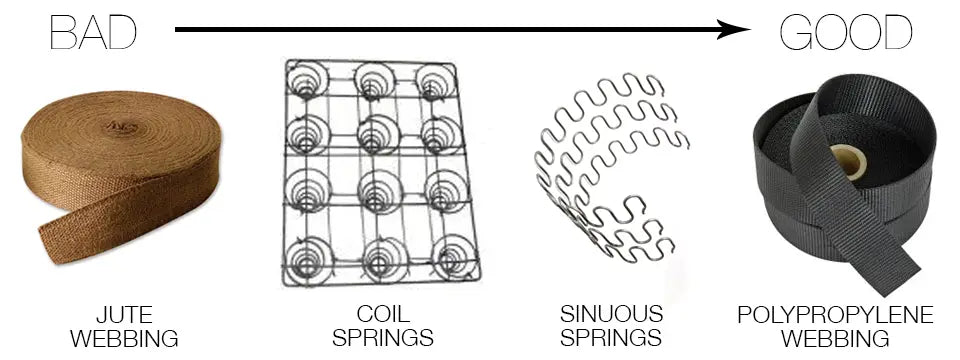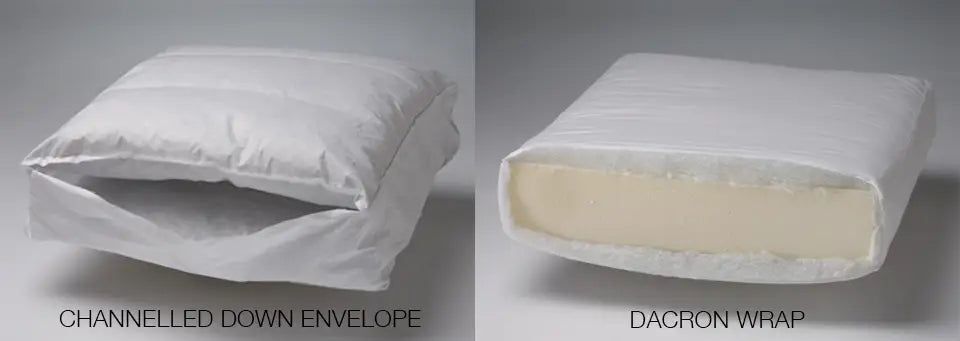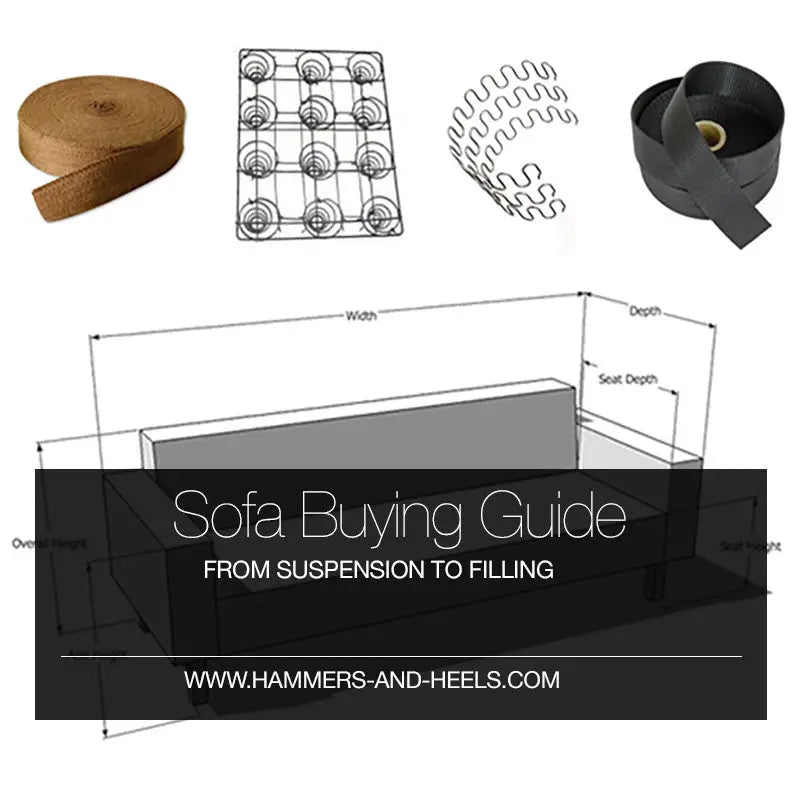With so many options available how can you possibly know what makes a piece of furniture quality? Disposable furniture seems cheaper, but that $300 sofa l only lasts 2 years, while a $3,000 couch will last you a lifetime. Lets pull out the old calculator on this one - $300 x 20 replacements and that $300 sofa will cost you $6,000. So how do you know what makes a good sofa?
Well, we’ll tell you.
THE FRAME

Good: Corner blocks.
All interior corners should have blocks for added strength. They should be glued and screwed into the frame, levitating blocks aren’t as sturdy as one may think.
Good: Glued, dowelled and screwed joints.
Most people don’t actually realize the strength of glue, probably because their primary encounter was with the joys of peeling it off their hands in elementary school. I definitely wouldn’t trust that to hold my sofa together. In truth, glued joints are often stronger than the grain itself! Combine that with a peg (dowell) that expands when glued to connect each piece together and it’s even stronger. Then, as though you couldn’t make it stronger than growing a tree in the shape of a sofa frame, you screw all of the joints together. Solid.
Good: Kiln-Dried alder or poplar frame.
Most people like to throw around the word hardwood, butthe reality is that hardwood just means “from a deciduous tree” and softwood means “from a coniferous tree.” But some hardwoods (like aspen) are softer than some softwoods. Knots in wood can cause cracks, but alder and poplar have few knots and tight grain making them ideal hardwoods. That said, some other hardwoods can work well. Kiln-drying also helps with strength. This process removes moisture from the wood making it less susceptible to shrinking and distorting the shape.
Bad: Plywood frame
Although plywood can be used in quality wood furniture, it is not recommended for upholstered frames as the stress of the decking is placed on the seams between the layers of plywood.
THE SUSPENSION
There are lots of options when it comes to suspensions (the part that holds you up when you sit down), so we’ll break down the typical options.

Bad: Jute webbing.
Lets be honest, there is a huge range of weights, qualities, and fiber contents found across jute webbing options. If a manufacturer wants to cut costs and the average consumer isn’t educated, webbing is the perfect choice. Most grades of jute webbing are only made for backs and arms and can not support the weight of multiple people over a period of time. Also it is known for sagging faster than any other suspension option. If you do purchase a piece of furniture with jute webbing make sure it is at least 11lbs per 144 yards. And good luck.
Overrated Eight-way hand tied springs.
Listen, we don’t stuff our cushions with hog hair anymore, so why is everyone still stuck on eight-way hand-tied coil springs a hundred years later? Maybe it sounds fancy? Well, the truth is there is no notable difference in quality or longevity when compared to sinuous springs or polypropylene webbing. Even Consumer Reports agrees! In fact, buying furniture that uses this outdated suspension pretty much just guarantees that when it does sag, squeak, or poke through, you will have a hefty bill for repairs. With recent manufacturing attempts to cut costs while trying to maintain something they can claim as a “spring” or “coil” seat, often times what a customer might think is eight-way hand tied spring suspension isn’t even remotely close. For a great example see coil cushions below or the image of a drop in spring unit above.
Good: Sinuous springs.
Sinuous springs are “S” shaped and run from the front of the seat to the back where they are clipped to the frame. These springs are connected using cord from side to side. They offer the spring of a coiled seat but unlike coil options if one fails you can replace a single one rather than the entire seat.
Good: Polypropylene webbing.
This stuff is literally seatbelt material. You trust them to keep you from flying from a vehicle, so it’ll have no problem keeping you 18” from the ground. Also, I am pretty sure car companies aren’t interested in getting sued so this webbing’s longevity and weight capacity is pretty solid. Polypropylene webbing is installed as bands that cross the seat and back. These are then attached to the frame to make a platform for the cushions. Make sure the webbing is attached to the frame using clips, not staples.
Good: Spacing less than 2”.
First of all, if you have sparsely spaced webbing or springs you’re going to feel it. Also, how is a loose net supposed to hold one human no less multiple … and a dog of course. To check spacing, remove the cushions and press down. There should be even resistance and pressure; you also should feel even spacing.
THE CUSHIONS

Good: Down Cushions.
If you want that sink-in, super-soft seat, go with down. Obviously, it’s the most expensive choice but hey, it’s an investment. Make sure they have down-proof ticking under the upholstery fabric so you don’t have feathers poking through. Also, check your down-to-feather ratios - paying for down and getting a bunch of feathers would be a waste of money. A great way to save money (and reduce the exhaustive time for maintenance) is to get a down envelope for your foam cushions. Make sure to get a channelled envelope so all of the down remains evenly dispersed.
Good: Dacron wrap.
Think of it as a nice thin blanket that wraps your cushions. It adds comfort but it also increases the longevity of your cushion.
Good: High density foam.
1.8 pounds or higher, only. Anything lower should not be used for furniture (at that point it’s only good for packing boxes). The rating is based on percentage of air to polyurethane. You don’t want to pay for a bunch of air, especially because air just escapes over time leaving you with sad saggy cushions. There is a myth going around that the higher the density the firmer the cushion. Not true. I mean, I guess the terminology sounds like that would be implied but it just isn’t true. You can get high density cushions in any firmness.
Bad: Shredded foam.
Yea, no, that’s real. Many manufacturers don’t actually use foam but instead just take remnants of foam, stuff them into a case and call it a cushion. Fail.
Good: High resiliency foam.
Now most people skim over this part because they have no idea what it means. It is the elasticity or springiness of the cushion.
Bad: Coil Cushions.
Ok, so I have a few qualms with coil cushions A.K.A. “Marshall Units.” First, sales associates try to sell them under verbiage that makes it sound like eight-way hand-tied springs. Second, putting metal directly in your cushion is a disaster waiting to happen when it inevitably fails and pokes through.
THE FABRIC
Good: Aligned Patterns.
For printed fabrics, the seam of the image repeat should line up properly so that you don’t see it repeating. Nobody wants their sofa looking like a patchwork quilt. With fabrics like linen, the weave should run in a straight line front to back and side to side, not sideways or distorted from improper stretching.
Good: Self-decking.
This just means the same fabric is used throughout the sofa including under the seat cushions. The only exclusion is leather, because when you put slippery fabrics together you find yourself on the floor. The good news is you would have a very nice floor cushion. Lemons into lemonade.
In closing, if you are out buying a sofa and the person trying to sell you said sofa can’t tell you about every aspect of construction … run. If you have any doubt whether they are telling the truth, make up a word and ask if that is the kind of suspension it has, if the answer is yes run. If the answer is no...run. If the answer is, “I have not heard of that type of suspension,” have a seat and see if it is at least comfortable.



12 comments
I purchased two recliner leather high leg chairs in May. The company is taking them in to refill the seat cushions because after 4 months of use they are flattened out. These were not cheap chairs and I have been told the cushions will be replaced with identical material and at the one year anniversary it will become my problem. Should I suggest paying extra to have a better density material used.
All couches, love seats have different suspension systems, cushioning, few frames. However suspension systems work the same. It depends on quality rather than quantity, sometimes.
Don’t let them bully you. Eight way is great but $$. Not used like it used to be.
PS anything made in the South Eas of The U.S. will usually be of quality!
Tony, it would take a diagram to explain eight way hand tied rings. Some say they are " high end " but I feel it makes for a long lasting suspension system .
Coil is a S from back to front or up and down if vertical. Look at a couch, imagine a rectangle with S coils ( set of 16) placed in the couch with some sort of density fiber over the coils, that is a S coil. Some say Eight Way is over rated. That all depends on the frame. eight Way is more complex, could have issues down the linenor ware and tare. They are $$$. Hope this helps.
I have had my chairs and sofa with 8 way hand tied springs, by Sherrill and Wesley Hall for literally 25 years. The only thing wrong after 25 years is the upholstery. All the other sofas I purchased with sinuous springs, etc., have not held up. So I do not really agree with everything this says based on my experience.
I agree with most of your information, but after selling furniture for 40 years and seeing the insides of furniture manufacturing, the components that go together are the key! I would never rate sinuous spring better than coil unless you are considering the comfort of the piece. Many people like sinuous because it offers the sit in it feel, where as a coil spring you tend to sit on! Coil springs do last much longer, and were usually found in sofas 20+ years old! Not many manufacturers use them today because of cost….. but definitely not due to quality! Sinuous can be good, but it comes back to the weight of the steel, the tempering of the steel, and now many there are! Wood and structural components all work with the spring construction to make a quality piece! Make sure to ask about the inside story when purchasing!